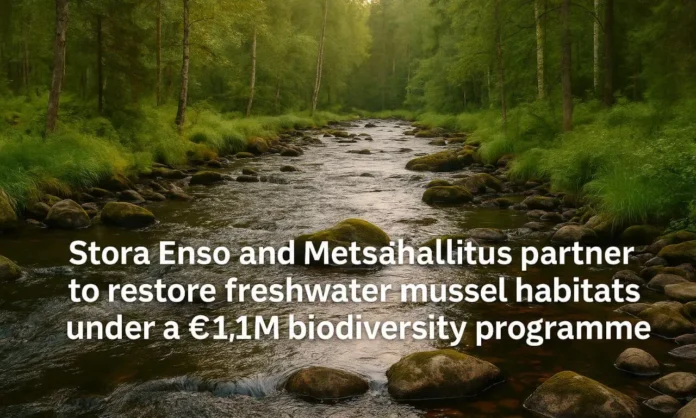Stora Enso has committed €1.1 million to restore endangered freshwater habitats in Finland — part of a landmark six-year biodiversity agreement with Metsähallitus Parks & Wildlife.
The focus? Saving one of Europe’s most overlooked aquatic species: the freshwater pearl mussel.
The partnership, which begins in July 2025 and runs until 2030, will fund hands-on river restoration, detailed species mapping, and new ecological safeguards — a significant response after the company faced criticism for environmental damage in 2024.
For the Nordic forest sector, it’s a rare move: a corporate-backed programme targeting a single species, backed by measurable outcomes and long-term engagement.
Mussels as a Measure of River Health
You won’t often spot one — but the freshwater pearl mussel has been holding on in Finland’s cleanest rivers for centuries.
In recent decades, though, their habitats have changed. Slowly at first. Then more rapidly.
What used to be stable, cold-water streams are now more prone to sediment, warmer flows, and changes in river structure.
For a species that needs consistent gravel beds and oxygen-rich water, even minor disruption can be the difference between survival and silence.
This new agreement is designed to reverse that trend.
“The programme is part of Stora Enso’s environmental sustainability action plan, launched after the environmental violation of Hukkajoki in 2024,” said Tuomas Tiilikainen, Head of Forest Finland at Stora Enso.
“I’m pleased with the agreement, which aims to improve the mussel’s living conditions in the best possible way.”
What the Programme Will Deliver
The Stora Enso biodiversity programme will be managed by Metsähallitus, the national wildlife and forest authority, with financial and technical backing from Stora Enso.
Together, the two organisations will:
Identify and map mussel habitats across priority regions
Restore damaged riverbeds and improve water flow
Monitor environmental changes through new data systems
Engage forestry staff in practical conservation activities
Annual work plans will be agreed jointly, allowing focus areas to shift based on new findings or urgent needs.
“Thanks to the funding, we can now act where before we couldn’t,” said Pekka Sulkava, Nature Conservation Director at Metsähallitus.
“That means collecting better data and rehabilitating waters that would otherwise be left behind. And it helps prevent the kind of damage we saw in Hukkajoki from happening again.”
Context: Learning From a Public Setback
The Hukkajoki case in 2024 placed Stora Enso’s environmental controls under scrutiny. Forestry activity had affected a sensitive watercourse, triggering media backlash and regulatory review.
The incident prompted the company to re-evaluate how biodiversity risks are identified and managed.
This new mussel programme is not only part of the company’s response — it’s also an opportunity to rebuild credibility and move beyond reactive environmental practices.
Where past efforts have been broad and generic, this one is precise, accountable, and built to deliver ecological benefit over time.
Part of a Bigger Trend in Forest Management
Across Europe, companies with forest land or timber operations are facing tougher questions on how they protect biodiversity — not just carbon stocks.
Nature-positive forestry, a once-niche idea, is now part of national regulation and global supply chain requirements.
In Sweden, wetland rehabilitation has been prioritised. In the UK, species-rich woodland planting is replacing monoculture spruce. And in Finland, the freshwater pearl mussel is now receiving the kind of attention long given to larger fauna.
With this €1.1M investment, Stora Enso is positioning itself at the front of that shift.
Technical Role and Employee Involvement
While Metsähallitus will lead ecological planning, Stora Enso’s support is more than financial.
The company is expected to:
Contribute mapping support through GIS and forest data
Assist with logistics in remote field areas
Involve its staff in restoration work — including riverbank stabilisation and habitat maintenance
It’s an unusual level of integration between corporate forestry teams and public conservation work — one that could set a precedent.
Timeline and Oversight
The agreement takes effect from 1 July 2025. Initial activity will focus on surveying habitats in Northern Finland, with site work beginning in 2026.
Progress reports will be published annually. A formal review is scheduled for 2028, with a final impact assessment due at the end of 2030.
Data collected through the programme will be made available to biodiversity databases and academic partners, adding further value beyond immediate field outcomes.
Why This Matters
Mussels aren’t charismatic. They don’t get media attention. But they tell us what’s happening beneath the surface — literally.
Their decline reflects wider problems in land use, water policy, and ecological planning. Their survival means a river is working as it should.
This programme, though niche on paper, is part of a much larger equation: how Europe’s forests, waterways, and industries learn to coexist.
And it’s a test of whether a forestry giant like Stora Enso can help turn that equation in the right direction.



